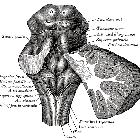Fossa rhomboidea

dea
{{PD-old}} modified from Gray"s Anatomy of the Human body, 1918, Copyright expired --[[User:Uwe Gille|Uwe Gille]] 10:30, 14 Jan 2005 (UTC) [[Category:Central nervous system]] [[Category:Media missing infob

Die
Rautengrube von dorsokranial (hinten oben), u. a. zu sehen ist das Trigonum nervi hypoglossi. Das Kleinhirn ist teilweise entfernt und nach rechts geklappt.
The rhomboid fossa is the shallow, diamond shaped depression on the dorsal surface of the pons and medulla oblongata thatforms the floor of the fourth ventricle . It is covered by grey matter which is continuous with the spinal cord.
It may be divided into two parts:
- superior
- upward triangular in shape
- limited laterally by the cerebellar peduncles and superiorly by the cerebral aqueduct
- base is an imaginary line in between the superior foveae
- inferior
- downward triangular in shape
- its tip continuous with the central canal of the spinal cord
Siehe auch:
und weiter:

 Assoziationen und Differentialdiagnosen zu Fossa rhomboidea:
Assoziationen und Differentialdiagnosen zu Fossa rhomboidea: